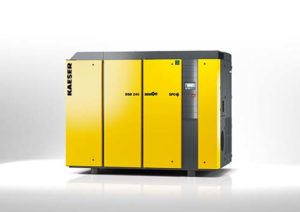 The next generation of DSD-series rotary screw compressors is now available for flow rates from 14 to 25 m³/min. Featuring all-new airends with high efficiency Sigma Profile rotors and IE4 motors, they deliver improved specific power of up to nine percent as well as up to six percent greater flow rates than previous models. These improvements, together with a host of other enhancements, result in significantly reduced energy costs, true to Kaeser’s motto of “More compressed air for less energy”.
The next generation of DSD-series rotary screw compressors is now available for flow rates from 14 to 25 m³/min. Featuring all-new airends with high efficiency Sigma Profile rotors and IE4 motors, they deliver improved specific power of up to nine percent as well as up to six percent greater flow rates than previous models. These improvements, together with a host of other enhancements, result in significantly reduced energy costs, true to Kaeser’s motto of “More compressed air for less energy”.
Maximum efficiency
The new IE4 Super Premium Efficiency motors, the most efficient currently available, also help to achieve this improvement and therefore enable peripheral losses in compressed air production to be reduced even further. Moreover, the Electronic Thermo Management (ETM) system regulates oil temperature to ensure a safe and consistent differential from the dew point temperature. This strategy also prevents unnecessarily high airend discharge temperatures and provides additional energy savings.
Heat recovery offers yet another key way to boost energy savings: a compressor transforms 100% of its input electrical drive power into heat, of which 96% can be recovered and reused for heating purposes. Kaeser engineers have now expanded the company’s range of heat recovery options with a small yet highly beneficial detail. In systems taking advantage of the heat recovery option, a second electronic Thermo Management system ensures optimised and even more efficient use of the available heat energy. If this heat energy is diverted to heat recovery systems in its entirety, the intelligent Sigma Control 2 controller recognises that it is no longer necessary for the compressor’s cooling system to provide cooling and consequently switches off the fluid cooler fan—effectively saving even more energy.
Energy-saving and environmentally friendly fluid filters
The unit interior also reflects Kaeser’s commitment to resource conservation: the environmentally friendly fluid filter cartridges no longer have a permanently attached sheet metal housing, but rather are simply inserted into an aluminium housing. The filter cartridges themselves feature a metal-free design and are suitable for thermal disposal at the end of their service life without additional pre-treatment.
Controller ensures optimum performance
The Sigma Control 2 controller is responsible for monitoring the compressor and, if equipped, the frequency converter (SFC option). This innovative controller also enables the compressor to connect to a network and facilitates straightforward connection to master control systems, such as the Sigma Air Manager 4.0 or other control centers—thereby making DSD units completely ready equipped for integration into Industry 4.0 environments.
Full range of models
The DSD series includes both air- and water-cooled models. Since variable-speed drive can be advantageous for certain applications, some versions are also available with variable-speed control implemented via a frequency converter (SFC option). As with the standard models, these versions are also designed with maximum efficiency, reliability and ease of maintenance in mind. Naturally as per the EMC Directive, the entire compressor system is tested and certified to EN 55011 Class A1 industrial network standards.
The new DSD series additionally features a range of important design improvements related to the optional integrated refrigeration dryer and system-integrated cooling air circuit (exhaust air). First, the depth of the integrated dryer has been reduced, enabling a corresponding 17% reduction of the T-version footprint compared to the previous version. As a result, the system’s refrigerant requirement has fallen around 30% and the power consumption of the integrated refrigeration dryer itself has been reduced by an impressive 25% compared to the previous version. Aside from the advantages of lower space and refrigerant requirement, these improvements also translate into significant cost savings.
Filed Under: Pneumatic Tips